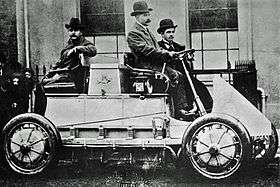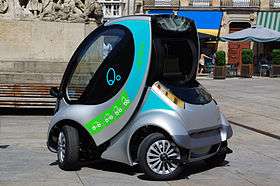Wheel hub motor
The wheel hub motor (also called wheel motor, wheel hub drive, hub motor or in-wheel motor) is an electric motor that is incorporated into the hub of a wheel and drives it directly.
History

- First wheel motor concept: Wellington Adams of St. Louis first conceived of building an electric motor directly in the vehicle wheel, though it was attached via complicated gearing. The Adams patent is U.S. Patent 300,827in 1884.
- High torque low RPM wheel motor invented: The motor was incorporated into the wheel without gearing and addressed torque considerations through the use of a new high torque, low rpm motor invented by Edward Parkhurst of Woburn, MA in U.S. Patent 422,149 in 1890 (and mismentioned in Parcelle's patent as #320,699).
- Electric wheel motor advantages revealed in patent: An early wheel hub electric motor was invented by Frenchman Charles Theryc and patented in 1896 as U.S. Patent 572,036 entitled Wheel with Electric Motor hub for Vehicles. In the patent he explained all advantages including no transmission losses because of the absence of classic transmission rods from engines to wheels.
- Diesel wheel motor: Not all wheel hub motors were electric. C F Goddard in 1896 invented a piston hub motor for horseless carriages patented in U.S. Patent 574,200. He envisioned it powered by expanding gas of some kind. His offcenter flexible bent spoke designs later appeared in the Apollo moon rovers' wheels in 1960s.
- Using cams, another type of combustion wheel motor: In U.S. Patent 593,248 W C Smith in 1897 developed another explosive gas expansion motor inside a wheel hub that utilized cams on a track in the hub to transmit power to the wheel.
The electric wheel hub motor was raced by Ferdinand Porsche in 1897 in Vienna, Austria. Porsche's first engineering training was electrical, not internal combustion based. As a result, he developed his first cars as electric cars with electric wheel hub motors that ran on batteries. The Lohner Porsche, fitted with one wheel motor in each of the front wheels, appeared at the World Exhibition in Paris in 1900 and created a sensation in the young automobile world. In the following years, 300 Lohner Porsches were made and sold to wealthy buyers.[3]
Eventually the growth in power of the gasoline engine overtook the power of the electric wheel hub motors and this made up for any losses through a transmission. As a result, autos moved to gasoline engines with transmissions, but they were never as efficient as electric wheel hub motors. A potential exception to this history occurred on 17 January 2012 with the granting of U.S. Patent 8,096,103, The General Wheel Rotation Power Motor, a pressure driven three cylinder wheel motor contained in the hub that applies this force through crank wheels directly to the rotating rim surrounding the hub.[4]
Uses in current and future vehicles
- They are commonly found on electric bicycles and motorcycles.[5]
- Wheel motors are applied in industry, e.g. driving wheels that are part of assembly lines.
- Tyre makers and component producers have developed them[6] and the first production car to use them was the Luka EV by MW Motors.[7]
- Hub motors can also be found on buses.[8]
Concept cars


Several concept cars have been developed using in-wheel motors:
- General Motors Sequel 2005
- Protean Electric's Mini QED in 2006, and other cars using its Hi-Pa Drive
- Mitsubishi MIEV concept model in 2005
- Chebela (2010), a small urban EV prototype using 2 direct-drive in-wheel motors in the rear.
- Citroën C-Métisse with in wheel electric motors developed by TM4.[9]
- Siemens VDO (bought by Continental) eCorner concept in 2006[10][11]
- Heuliez WILL using the Michelin Active Wheel (which incorporates motorized active suspension as well) in 2008[12]
- The ZAP-X in 2007 "would use high-tech electric hub motors at all four wheels, delivering 644 horsepower to the ground from a lithium-ion battery pack. The hub motors would eliminate the need for transmission, axles and conventional brakes, opening up space beneath the floor for a giant battery pack."[13]
- The Peugeot BB1 in 2009 incorporates rear in-wheel motors designed with Michelin.[14]
- The Protean Ford F-150 All-Electric Pickup Truck by Protean Electric uses four in-wheel motors.[15]
- The Hiriko folding urban electric prototype has the drive motors located inside each of the four wheels, and has an electronically controlled maximum speed of 50 km/h (31 mph).[16][17] Each wheel integrates a motor, steering actuators, suspension and braking right inside the wheel, controlled by a drive-by-wire system.[18]
Mechanism
Hub motor electromagnetic fields are supplied to the stationary windings of the motor. The outer part of the motor follows, or tries to follow, those fields, turning the attached wheel. In a brushed motor, energy is transferred by brushes contacting the rotating shaft of the motor. Energy is transferred in a brushless motor electronically, eliminating physical contact between stationary and moving parts. Although brushless motor technology is more expensive, most are more efficient and longer-lasting than brushed motor systems.
A hub motor typically is designed in one of three configurations. Considered least practical is an axial-flux motor, where the stator windings are typically sandwiched between sets of magnets. The other two configurations are both radial designs with the motor magnets bonded to the rotor; in one, the inner rotation motor, the rotor sits inside the stator, as in a conventional motor. In the other, the outer-rotation motor, the rotor sits outside the stator and rotates around it. The application of hub motors in vehicular uses is still evolving, and neither configuration has become standard.[19]
Electric motors have their greatest torque at startup, making them ideal for vehicles as they need the most torque at startup too. The idea of "revving up" so common with internal combustion engines is unnecessary with electric motors. Their greatest torque occurs as the rotor first begins to turn, which is why electric motors do not require a transmission. A gear-down arrangement may be needed, but unlike in a transmission normally paired with a combustion engine, no shifting is needed for electric motors.[20]
Wheel hub motors are increasingly common on electric bikes and electric scooters in some parts of the world, especially Asia.[21][22]
Comparison with conventional EV design in automobiles
Compared with the conventional electric vehicle design with one motor situated centrally driving two (sometimes four) wheels by axles, the wheel motor arrangement has certain advantages and disadvantages:
Drive by wire

Cars with electronic control of brakes and acceleration for each individual wheel provide more opportunities for computerized vehicle dynamics such as:
- 360 degree steering[23]
- Brake steer, where individual wheel brake bias is adjusted to assist steering (similar to a tracked vehicle like a bulldozer)[24]
- Active software differentials, where individual wheel speed is adjusted in response to other inputs
- Active brake bias, where individual wheel brake effort is adjusted in real time to maintain vehicle stability
As wheel motors brake and accelerate a vehicle with a single solid state electric/electronic system many of the above features can be added as software upgrades rather than requiring additional systems/hardware be installed. This should lead to cheaper active dynamic safety systems for wheel motor equipped road vehicles.
Weight savings
Eliminating mechanical transmission, including gearboxes, differentials, drive shafts, and axles, provides a significant weight and manufacturing cost saving, while also decreasing the environmental impact of the product.[25]
Unsprung weight concerns
The major disadvantage of a wheel hub motor is that the weight of the electric motor increases the unsprung weight, which adversely affects handling and ride. The wheels are more sluggish in responding to road conditions, especially fast motions over bumps, and transmit the bumps to the chassis instead of absorbing them.
Most conventional electric motors include ferrous material composed of laminated electrical steel. This ferrous material contributes most of the weight of electric motors. To minimize this weight, several recent wheel-motor designs have minimized the electrical steel content of the motor by using a coreless design with Litz wire coil windings to reduce eddy current losses. This significantly reduces wheel motor weight and therefore unsprung weight.
Another method used is to replace the cast iron friction brake assembly with a wheel motor assembly of similar weight. This results in no net gain in unsprung weight and provides a car capable of braking up to 1G.[26]
A good example of this is the Michelin Active Wheel motor as fitted to the Heuliez Will, the first electric car with an Active Wheel drive, which results in an unsprung weight of 35 kg on the front axle and which compares favorably to a small car such as a Renault Clio that has 38 kg of unsprung weight on its front axle.[27]
References
- "History of Hybrid Vehicles". HybridCars.com. 27 March 2006. Archived from the original on 4 September 2009. Retrieved 21 March 2010.
- Mixte Voiturette
- "Milestones - Porsche History". US: Porsche. Archived from the original on 18 December 2005.
- US Pat Office
- "electric motorcycle". Electrek. Retrieved 31 August 2019.
- "A new type of engine for electric cars". The Economist. 11 July 2019. ISSN 0013-0613. Retrieved 31 August 2019.
- "Luka EV". MW Motors. Retrieved 12 September 2016.
- "Wheel Motors to Drive Dutch Buses". Technology Review. 23 March 2009. Retrieved 23 November 2009.
- "TM4 has developed and produced the electric motors used on the CITROËN C-Métisse concept car". TM4. Archived from the original on 29 October 2013. Retrieved 18 July 2013.
- "Siemen's VDO's by-wire technology turns the ecorner". VDO. 16 October 2006. Archived from the original on 18 January 2008.
- "Car motors will disappear – into the wheels". VDO. 8 August 2006. Archived from the original on 27 May 2008.
- "MICHELIN ACTIVE WHEEL Press Kit". Michelin. 26 September 2008. Retrieved 15 September 2009.
- Ulrich, Lawrence (23 September 2007). "They're Electric, but Can They Be Fantastic?". The New York Times.
- "Peugeot Shows Two HYbrid4 Concepts, New BB1 EV Concept at Frankfurt". Green Car Congress. 15 September 2009. Retrieved 31 May 2010.
- "Test drive of new in-wheel electric motored pickup truck". 15 September 2009. Retrieved 31 May 2011.
- "Hiriko electric city car folds up to save space". Wired UK. 26 January 2012. Retrieved 1 February 2012.
- Jimmy Hitipeuw (30 January 2012). "The Folding Electric Car". Kompas.com. Archived from the original on 2 February 2012. Retrieved 16 July 2012.
- James Holloway (20 February 2012). "Hiriko - the fold-up electric two-seater set for 2013". Gizmag. Retrieved 26 July 2012.
- "Designing In-Hub Brushless Motors". machinedesign.com.
- "the rad power electric bike is part moped and part cargo bike". designboom | architecture & design magazine. 27 August 2019. Retrieved 31 August 2019.
- "Information about Hub Motors". ebikes.ca. Canada. Archived from the original on 9 February 2008.
- "Rear Hub Motors, Electric Vehicle Propulsion Systems, Phoenix, RoadRunner, Sparrow Hub Motors". Electric Rider. US. Archived from the original on 20 October 2006.
- "Protean module gives 360-degree manoeuvrability". electrive.com. 18 July 2019. Retrieved 31 August 2019.
- Roberson, Bill. "What Should Be Next For Electric Vehicles: Real All-Wheel Steering". Forbes. Retrieved 31 August 2019.
- "Aptera Is Back, Baby! New, Improved Electric Car Will Have 1,000 Mile Range". CleanTechnica. 29 August 2019. Retrieved 31 August 2019.
- Michelin Hy-Light Active Wheel Motor EV concept Car. Retrieved 27 May 2020 – via YouTube.
- Lepisto, Christine. "Michelin Unveils Active Wheel in Affordable Electric Car". Archived from the original on 18 March 2009.
External links
| Wikimedia Commons has media related to In-wheel motors. |
- e-Traction in-wheel direct drive technology
- Mitsubishi' experimental car, presented in May 2005, is fitted with wheel motors at the rear.
- The ez-Wheel
- Elaphe performance in-wheel electric motors